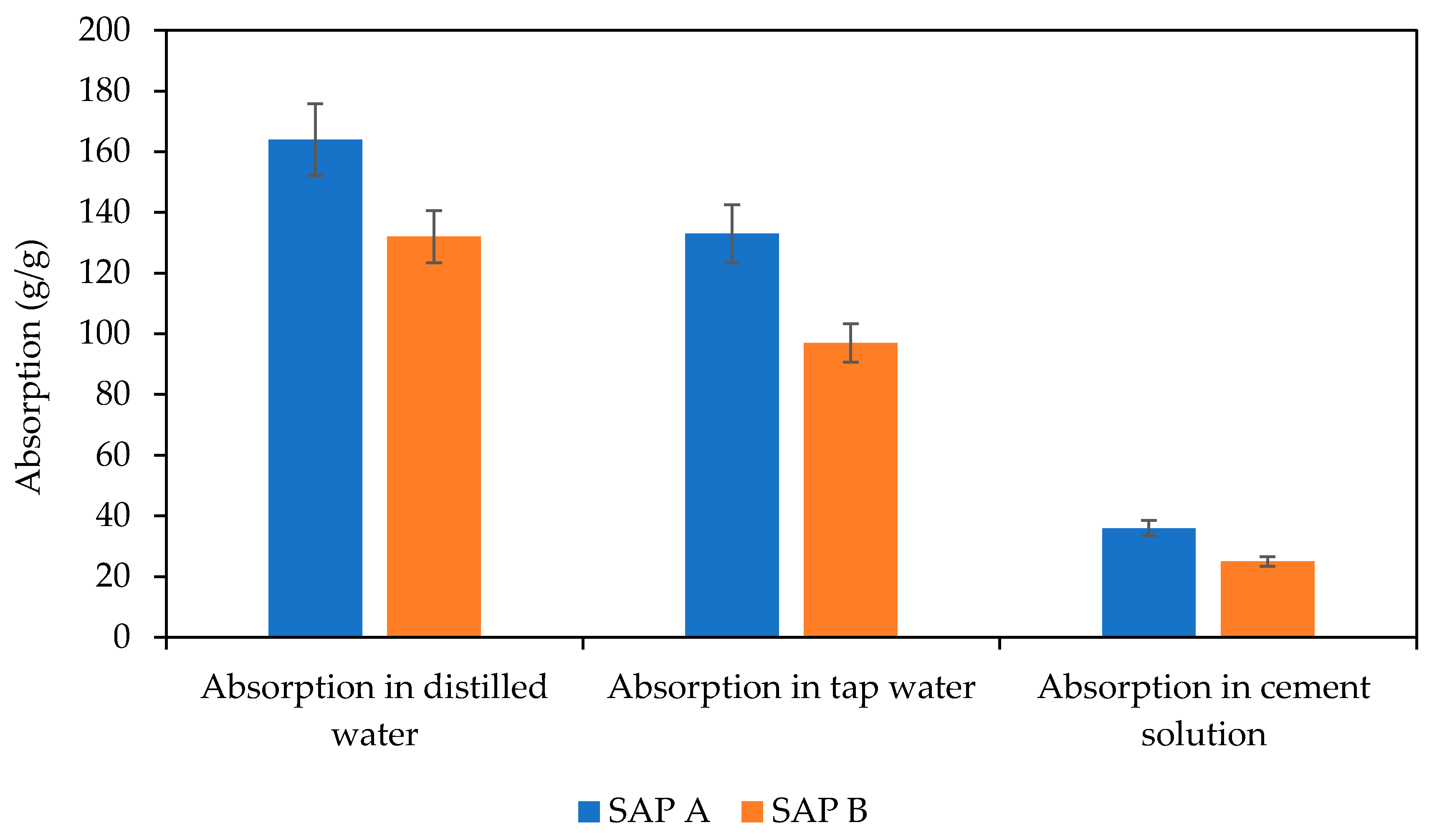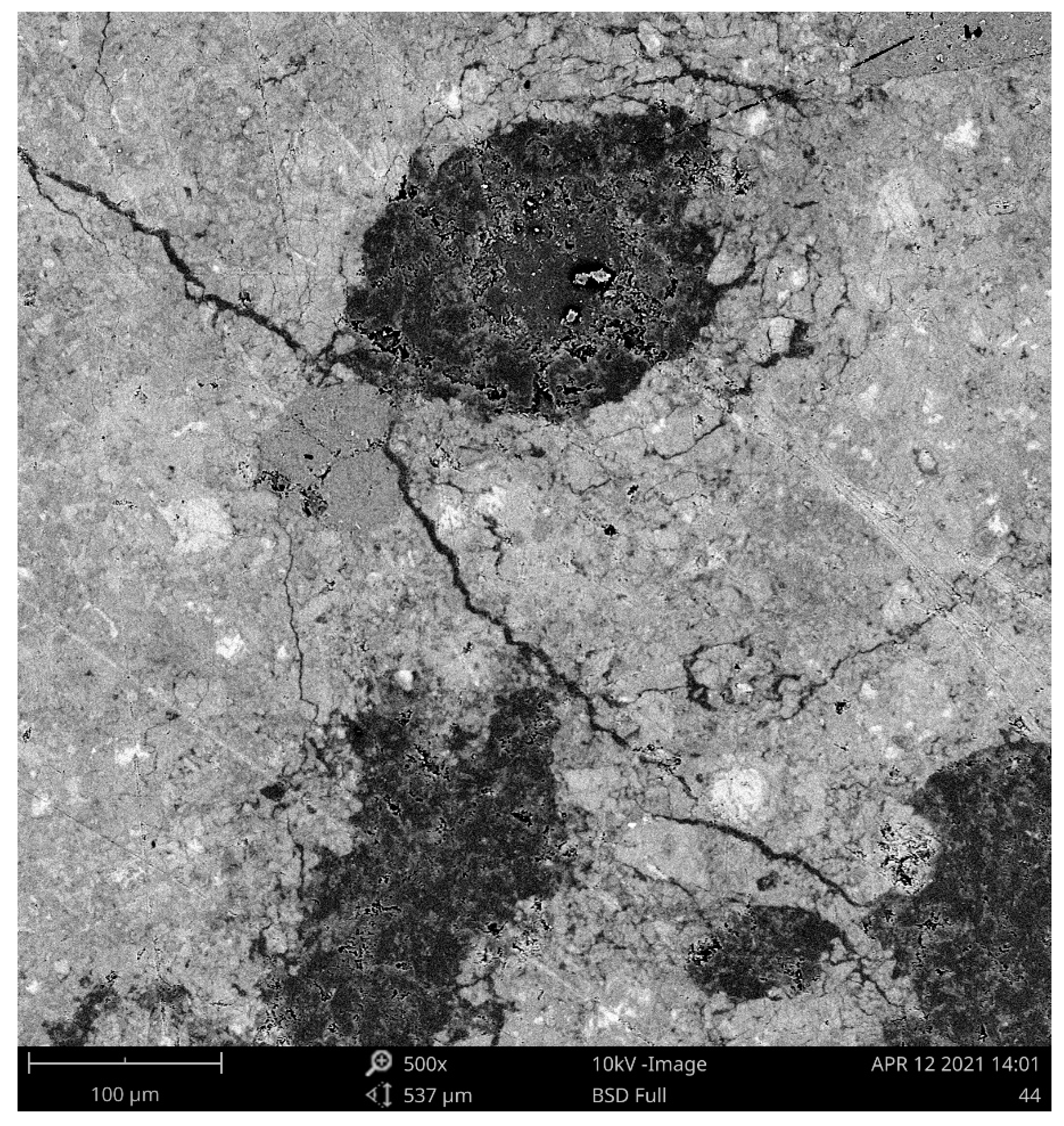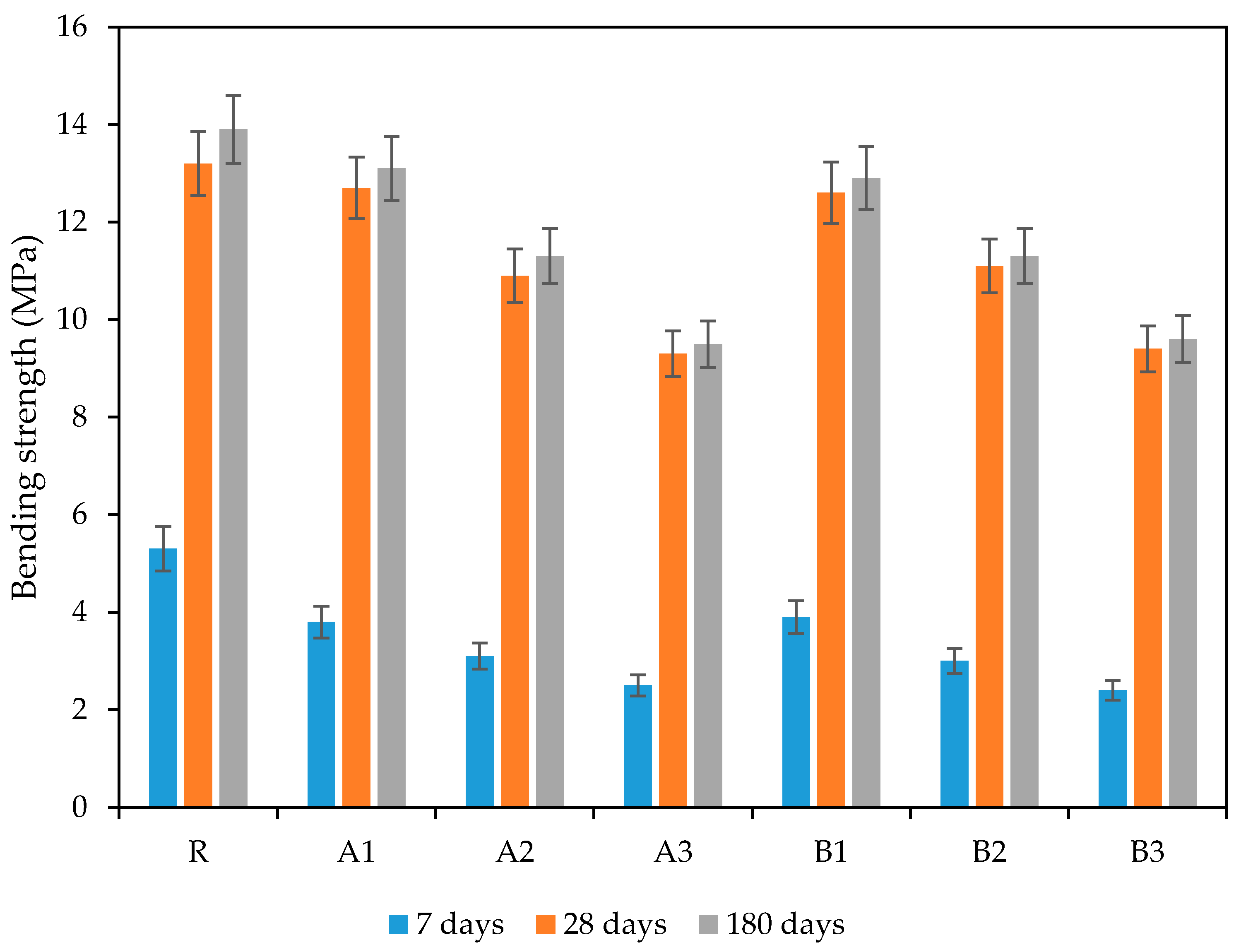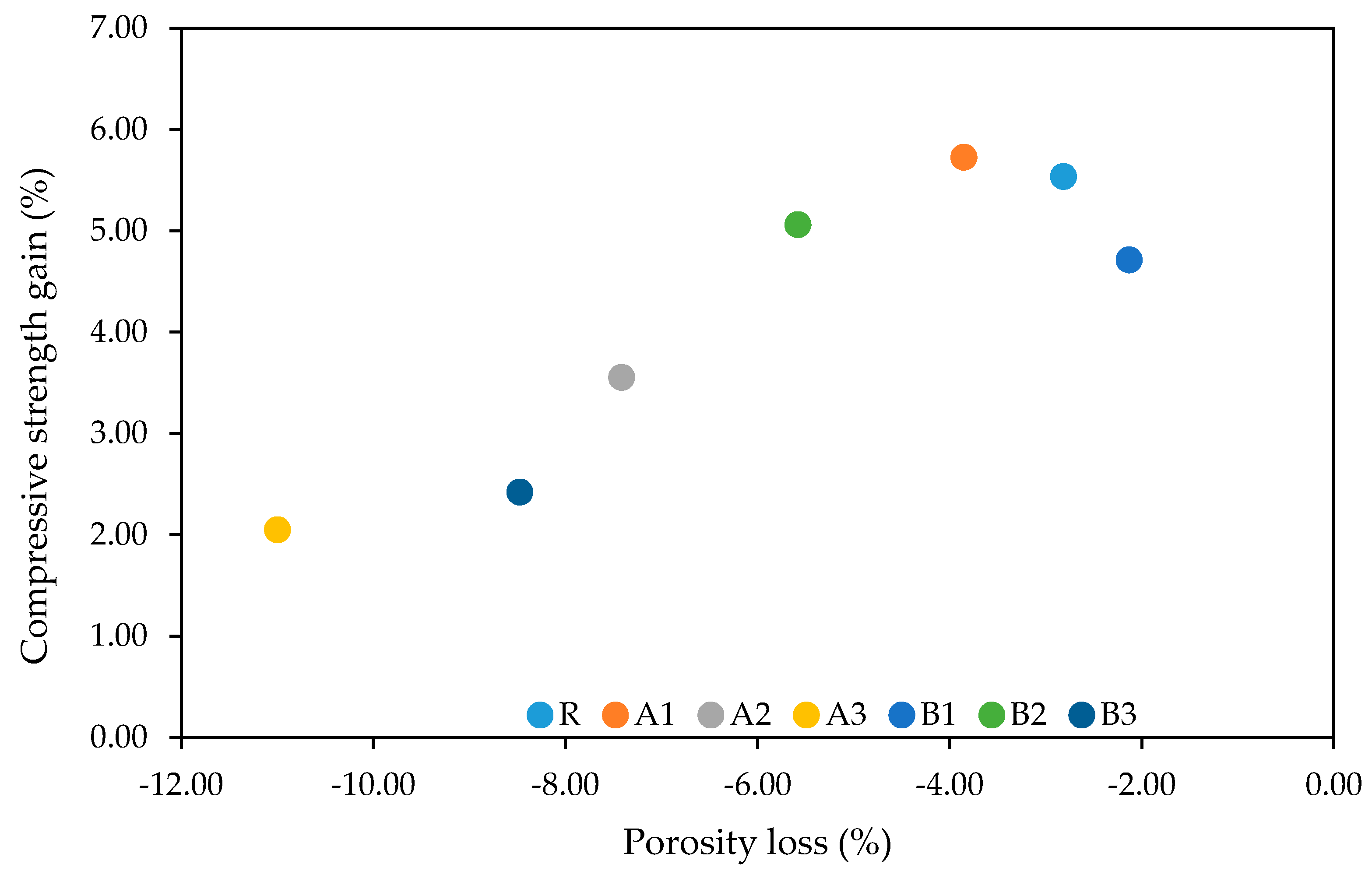Microstructure Formation of Cement Mortars Modified by Superabsorbent Polymers
Abstract
:1. Introduction
2. Materials and Methods
2.1. Studied Materials
2.2. Mortars Design
2.3. Experimental Methods
2.3.1. Scanning Electron Microscopy
2.3.2. X-ray Computed Tomography Analysis
2.3.3. Hydration Heat Evolution
2.3.4. Shrinkage
2.3.5. Basic Physical Characteristics
2.3.6. Mercury Intrusion Porosimetry
2.3.7. Mechanical Properties
3. Results and Discussion
4. Conclusions
- The application of SAPs lowered the main hydration peak at 10 h, while the cumulative heat evolution of the SAP-modified pastes dominated over the reference mixture, in the reverse order.
- The effect of cross-linking density was rather minor, in terms of mechanical and bending strengths. The slight variation in the observed material properties can be attributed to the reduced deswelling rate by superabsorbents with lower cross-linking densities.
- SEM analysis, performed together with XCT, revealed a regular distribution of incorporated SAP particles with only minor clumping. This finding suggests that the benefits associated with SAPs’ application, such as mitigation of autogenous shrinkage and crack self-healing, occur proportionally in the material matrix. Furthermore, the cracks formed in the SAP particles’ surroundings were filled by the swollen hydrogel and promoted self-healing, due to improved internal curing.
- The benefits associated with the mitigation of autogenous shrinkage varied positively with dosage. Slightly more favorable results were obtained for the mixture modified by SAPs with higher cross-linking densities.
- The application of superabsorbent polymers increased pore volume in the range of 10–100 nm at 28 days, however, at 180 days, the observed change in porosity was reduced to the almost same level as the reference mixture. This phenomenon can be attributed to the formation of affected zones around the SAP particles, which was responsible for the closing of open pores. In this regard, MIP analysis may result in a significant distortion of real porosity values, due to decreased penetration of older samples. Moreover, swollen SAPs in the inner structure of mortars fill the voids formed by the hydrogel, however, such filled voids further deteriorate the mechanical strength.
Author Contributions
Funding
Institutional Review Board Statement
Informed Consent Statement
Data Availability Statement
Conflicts of Interest
References
- de Brito, J.; Kurda, R. The past and future of sustainable concrete: A critical review and new strategies on cement-based materials. J. Clean. Prod. 2021, 281, 72. [Google Scholar] [CrossRef]
- Cabeza, L.F.; Boquera, L.; Chàfer, M.; Vérez, D. Embodied energy and embodied carbon of structural building materials: Worldwide progress and barriers through literature map analysis. Energy Build. 2021, 231, 110612. [Google Scholar] [CrossRef]
- Jittin, V.; Rithuparna, R.; Bahurudeen, A.; Pachiappan, B. Synergistic use of typical agricultural and industrial by-products for ternary cement: A pathway for locally available resource utilisation. J. Clean. Prod. 2021, 279, 123448. [Google Scholar] [CrossRef]
- Gupta, N.; Siddique, R.; Belarbi, R. Sustainable and Greener Self-Compacting Concrete incorporating Industrial By-Products: A Review. J. Clean. Prod. 2021, 284, 124803. [Google Scholar] [CrossRef]
- Wu, L.; Farzadnia, N.; Shi, C.; Zhang, Z.; Wang, H. Autogenous shrinkage of high performance concrete: A review. Constr. Build. Mater. 2017, 149, 62–75. [Google Scholar] [CrossRef]
- Yang, L.; Shi, C.; Liu, J.; Wu, Z. Factors affecting the effectiveness of internal curing: A review. Constr. Build. Mater. 2021, 267, 13. [Google Scholar] [CrossRef]
- Liu, J.; Farzadnia, N.; Khayat, K.H.; Shi, C. Effects of SAP characteristics on internal curing of UHPC matrix. Constr. Build. Mater. 2021, 280, 122530. [Google Scholar] [CrossRef]
- Shah, S.N.; Mo, K.H.; Yap, S.P.; Yang, J.; Ling, T.-C. Lightweight foamed concrete as a promising avenue for incorporating waste materials: A review. Resour. Conserv. Recycl. 2021, 164, 105103. [Google Scholar] [CrossRef]
- Hossain, S.S.; Mathur, L.; Majhi, M.R.; Roy, P.K. Manufacturing of green building brick: Recycling of waste for construction purpose. J. Mater. Cycles Waste Manag. 2018, 21, 281–292. [Google Scholar] [CrossRef]
- Fořt, J.; Šál, J.; Žák, J.; Černý, R. Assessment of Wood-Based Fly Ash as Alternative Cement Replacement. Sustainability 2020, 12, 9580. [Google Scholar] [CrossRef]
- Baloch, H.; Usman, M.; Rizwan, S.A.; Hanif, A. Properties enhancement of super absorbent polymer (SAP) incorporated self-compacting cement pastes modified by nano silica (NS) addition. Constr. Build. Mater. 2019, 203, 18–26. [Google Scholar] [CrossRef]
- Zohuriaan-Mehr, M.J.; Kabiri, K. Superabsorbent polymer materials: A review. Iran. Polym. J. 2008, 17, 451–477. [Google Scholar]
- Fořt, J.; Migas, P.; Černý, R. Effect of Absorptivity of Superabsorbent Polymers on Design of Cement Mortars. Materials 2020, 13, 5503. [Google Scholar] [CrossRef]
- Yang, J.; Sun, Z.; Zhao, Y.; Ji, Y.; Li, B. The Water Absorption-release of Superabsorbent Polymers in Fresh Cement Paste: An NMR Study. J. Adv. Concr. Technol. 2020, 18, 139–145. [Google Scholar] [CrossRef] [Green Version]
- Liu, J.H.; Farzadnia, N.; Shi, C.J.; Ma, X.W. Effects of superabsorbent polymer on shrinkage properties of ultra-high strength concrete under drying condition. Constr. Build. Mater. 2019, 215, 799–811. [Google Scholar] [CrossRef]
- Olawuyi, B.J.; Babafemi, A.J.; Boshoff, W.P. Early-age and long-term strength development of high-performance concrete with SAP. Constr. Build. Mater. 2021, 267, 121798. [Google Scholar] [CrossRef]
- Fan, J.; Shen, A.; Guo, Y.; Zhao, M.; Yang, X.; Wang, X. Evaluation of the shrinkage and fracture properties of hybrid Fiber-Reinforced SAP modified concrete. Constr. Build. Mater. 2020, 256, 119491. [Google Scholar] [CrossRef]
- Danish, A.; Mosaberpanah, M.A.; Salim, M.U. Robust evaluation of superabsorbent polymers as an internal curing agent in cementitious composites. J. Mater. Sci. 2020, 56, 136–172. [Google Scholar] [CrossRef]
- Aparicio, S.; Hernández, M.; Anaya, J. Influence of environmental conditions on concrete manufactured with recycled and steel slag aggregates at early ages and long term. Constr. Build. Mater. 2020, 249, 118739. [Google Scholar] [CrossRef]
- Hawreen, A.; Bogas, J. Creep, shrinkage and mechanical properties of concrete reinforced with different types of carbon nanotubes. Constr. Build. Mater. 2019, 198, 70–81. [Google Scholar] [CrossRef]
- Ferraro, A.; Colangelo, F.; Farina, I.; Race, M.; Cioffi, R.; Cheeseman, C.; Fabbricino, M. Cold-bonding process for treatment and reuse of waste materials: Technical designs and applications of pelletized products. Crit. Rev. Environ. Sci. Technol. 2021, 51, 2197–2231. [Google Scholar] [CrossRef]
- Fernandez, C.A.; Correa, M.; Nguyen, M.-T.; Rod, K.A.; Dai, G.L.; Cosimbescu, L.; Rousseau, R.; Glezakou, V.-A. Progress and challenges in self-healing cementitious materials. J. Mater. Sci. 2020, 56, 201–230. [Google Scholar] [CrossRef]
- Guo, Y.; Zhang, P.; Ding, H.; Le, C. Experimental Study on the Permeability of SAP Modified Concrete. Materials 2020, 13, 3368. [Google Scholar] [CrossRef] [PubMed]
- Chindasiriphan, P.; Yokota, H.; Pimpakan, P. Effect of fly ash and superabsorbent polymer on concrete self-healing ability. Constr. Build. Mater. 2020, 233, 116975. [Google Scholar] [CrossRef]
- Li, D.; Chen, B.; Chen, X.; Fu, B.; Wei, H.; Xiang, X. Synergetic effect of superabsorbent polymer (SAP) and crystalline admixture (CA) on mortar macro-crack healing. Constr. Build. Mater. 2020, 247, 118521. [Google Scholar] [CrossRef]
- Yang, H.; Liu, J.; Jia, X.; Zhou, Y.; Ji, H. Influence of NaCl concentrations on the crack-sealing behavior of superabsorbent polymers in cementitious materials. Constr. Build. Mater. 2020, 243, 118228. [Google Scholar] [CrossRef]
- Wang, F.; Yang, J.; Hu, S.; Li, X.; Cheng, H. Influence of superabsorbent polymers on the surrounding cement paste. Cem. Concr. Res. 2016, 81, 112–121. [Google Scholar] [CrossRef]
- Snoeck, D.; Pel, L.; De Belie, N. Comparison of different techniques to study the nanostructure and the microstructure of cementitious materials with and without superabsorbent polymers. Constr. Build. Mater. 2019, 223, 244–253. [Google Scholar] [CrossRef]
- Tan, Y.; Lu, X.; He, R.; Chen, H.; Wang, Z. Influence of superabsorbent polymers (SAPs) type and particle size on the performance of surrounding cement-based materials. Constr. Build. Mater. 2021, 270, 121442. [Google Scholar] [CrossRef]
- He, Z.; Shen, A.; Guo, Y.; Lyu, Z.; Li, D.; Qin, X.; Zhao, M.; Wang, Z. Cement-based materials modified with superabsorbent polymers: A review. Constr. Build. Mater. 2019, 225, 569–590. [Google Scholar] [CrossRef]
- Schröfl, C.; Snoeck, D.; Mechtcherine, V. A review of characterisation methods for superabsorbent polymer (SAP) samples to be used in cement-based construction materials: Report of the RILEM TC 260-RSC. Mater. Struct. 2017, 50, 50. [Google Scholar] [CrossRef]
- Kim, I.S.; Choi, S.Y.; Choi, Y.S.; Yang, E.I. An experimental study on absorptivity measurement of superabsorbent polymers (SAP) and effect of SAP on freeze-thaw resistance in mortar specimen. Constr. Build. Mater. 2021, 267, 120974. [Google Scholar] [CrossRef]
- Agostinho, L.B.; Alexandre, D.P.; da Silva, E.F.; Toledo, R.D. Rheological study of Portland cement pastes modified with superabsorbent polymer and nanosilica. J. Build. Eng. 2021, 34, 8. [Google Scholar]
- Zhang, B.; Li, Q.; Ma, R.; Niu, X.; Yang, L.; Hu, Y.; Zhang, J. The Influence of a Novel Hydrophobic Agent on the Internal Defect and Multi-Scale Pore Structure of Concrete. Materials 2021, 14, 609. [Google Scholar] [CrossRef]
- Kalinowski, M.; Woyciechowski, P.P.; Sokołowska, J. Effect of mechanically-induced fragmentation of polyacrylic superabsorbent polymer (SAP) hydrogel on the properties of cement composites. Constr. Build. Mater. 2020, 263, 120135. [Google Scholar] [CrossRef]
- Lefever, G.; Aggelis, D.G.; De Belie, N.; Raes, M.; Hauffman, T.; Van Hemelrijck, D.; Snoeck, D. The Influence of Superabsorbent Polymers and Nanosilica on the Hydration Process and Microstructure of Cementitious Mixtures. Materials 2020, 13, 5194. [Google Scholar] [CrossRef]
- Lee, H.; Wong, H.; Buenfeld, N. Self-sealing of cracks in concrete using superabsorbent polymers. Cem. Concr. Res. 2016, 79, 194–208. [Google Scholar] [CrossRef] [Green Version]
- Schröfl, C.; Mechtcherine, V.; Gorges, M. Relation between the molecular structure and the efficiency of superabsorbent polymers (SAP) as concrete admixture to mitigate autogenous shrinkage. Cem. Concr. Res. 2012, 42, 865–873. [Google Scholar] [CrossRef]
- Fořt, J.; Doleželová, M.; Kočí, V.; Černý, R. Functional Properties of SAP-Based Humidity Control Plasters. Polymers 2021, 13, 2279. [Google Scholar] [CrossRef]
- Justs, J.; Wyrzykowski, M.; Winnefeld, F.; Bajare, D.; Lura, P. Influence of superabsorbent polymers on hydration of cement pastes with low water-to-binder ratio. J. Therm. Anal. Calorim. 2014, 115, 425–432. [Google Scholar] [CrossRef]
- Urgessa, G.; Choi, K.-B.; Yeon, J.H. Internal Relative Humidity, Autogenous Shrinkage, and Strength of Cement Mortar Modified with Superabsorbent Polymers. Polymers 2018, 10, 1074. [Google Scholar] [CrossRef] [Green Version]
- Ma, X.; Yuan, Q.; Liu, J.; Shi, C. Effect of water absorption of SAP on the rheological properties of cement-based materials with ultra-low w/b ratio. Constr. Build. Mater. 2019, 195, 66–74. [Google Scholar] [CrossRef]
- Tan, Y.; Chen, H.; Wang, Z.; Xue, C.; He, R. Performances of Cement Mortar Incorporating Superabsorbent Polymer (SAP) Using Different Dosing Methods. Materials 2019, 12, 1619. [Google Scholar] [CrossRef] [Green Version]
- Song, C.; Choi, Y.C.; Choi, S. Effect of internal curing by superabsorbent polymers—Internal relative humidity and autogenous shrinkage of alkali-activated slag mortars. Constr. Build. Mater. 2016, 123, 198–206. [Google Scholar] [CrossRef]
- Farzanian, K.; Ghahremaninezhad, A. Desorption of superabsorbent hydrogels with varied chemical compositions in cementitious materials. Mater. Struct. 2018, 51, 3. [Google Scholar] [CrossRef]
- Yang, J.; Wang, F. Influence of assumed absorption capacity of superabsorbent polymers on the microstructure and performance of cement mortars. Constr. Build. Mater. 2019, 204, 468–478. [Google Scholar] [CrossRef]
- Kanellopoulou, I.A.; Kartsonakis, I.A.; Charitidis, C.A. The Effect of Superabsorbent Polymers on the Microstructure and Self-Healing Properties of Cementitious-Based Composite Materials. Appl. Sci. 2021, 11, 700. [Google Scholar] [CrossRef]
- Klemm, A.J.; Sikora, K.S. The effect of Superabsorbent Polymers (SAP) on microstructure and mechanical properties of fly ash cementitious mortars. Constr. Build. Mater. 2013, 49, 134–143. [Google Scholar] [CrossRef]
- Sun, B.; Wu, H.; Song, W.; Li, Z.; Yu, J. Design methodology and mechanical properties of Superabsorbent Polymer (SAP) cement-based materials. Constr. Build. Mater. 2019, 204, 440–449. [Google Scholar] [CrossRef]
- Farzanian, K.; Teixeira, K.P.; Rocha, I.P.; Carneiro, L.D.S.; Ghahremaninezhad, A. The mechanical strength, degree of hydration, and electrical resistivity of cement pastes modified with superabsorbent polymers. Constr. Build. Mater. 2016, 109, 156–165. [Google Scholar] [CrossRef]
- Sun, B.; Wu, H.; Song, W.; Li, Z.; Yu, J. Hydration, microstructure and autogenous shrinkage behaviors of cement mortars by addition of superabsorbent polymers. Front. Struct. Civ. Eng. 2020, 14, 1274–1284. [Google Scholar] [CrossRef]
- Dang, J.; Zhao, J.; Du, Z. Effect of Superabsorbent Polymer on the Properties of Concrete. Polymers 2017, 9, 672. [Google Scholar] [CrossRef] [PubMed] [Green Version]
- Abed, M.; Nemes, R. Long-term durability of self-compacting high-performance concrete produced with waste materials. Constr. Build. Mater. 2019, 212, 350–361. [Google Scholar] [CrossRef]
- Popovics, S. Analysis of the concrete strength versus water-cement ratio relationship. Mater. J. 1990, 87, 517–529. [Google Scholar]












| SiO2 | CaO | Al2O3 | Fe2O3 | Na2O | K2O | SO3 | Cl− | MgO | LOI |
|---|---|---|---|---|---|---|---|---|---|
| 21.78 | 65.49 | 4.13 | 0.41 | 0.32 | 0.33 | 3.32 | 0.01 | 1.35 | 2.36 |
| Cement (kg/m3) | w/c | SP (%) | A/C | SAP (%) | Ew (%) | |
|---|---|---|---|---|---|---|
| R | 500 | 0.3 | 0.3 | 2 | 0 | 0 |
| A1 | 0.3 | 2.3 | ||||
| A2 | 0.6 | 5.87 | ||||
| A3 | 0.9 | 11.6 | ||||
| B1 | 0.3 | 1.8 | ||||
| B2 | 0.6 | 5.37 | ||||
| B3 | 0.9 | 10.3 |
| Mixture | Matrix Density (kg/m3) | Bulk Density (kg/m3) | Open Porosity (%) |
|---|---|---|---|
| R | 2715 ± 13 | 2280 ± 21 | 16.0 ± 1.2 |
| A1 | 2714 ± 15 | 2229 ± 18 | 17.9 ± 1.4 |
| A2 | 2712 ± 15 | 2165 ± 19 | 20.2 ± 1.1 |
| A3 | 2709 ± 14 | 2087 ± 16 | 22.9 ± 1. 3 |
| B1 | 2715 ± 10 | 2238 ± 17 | 17.6 ± 1.4 |
| B2 | 2714 ± 13 | 2181 ± 18 | 19.6 ± 1.1 |
| B3 | 2710 ± 16 | 2113 ± 15 | 22.1 ± 1.2 |
| Mixture | Matrix Density (kg/m3) | Bulk Density (kg/m3) | Open Porosity (%) |
|---|---|---|---|
| R | 2723 ± 11 | 2299 ± 18 | 15.6 ± 1.0 |
| A1 | 2718 ± 14 | 2251 ± 19 | 17.2 ± 1.2 |
| A2 | 2715 ± 12 | 2208 ± 21 | 18.7 ± 1.1 |
| A3 | 2711 ± 12 | 2157 ± 17 | 20.4 ± 1.3 |
| B1 | 2716 ± 13 | 2249 ± 18 | 17.2 ± 1.1 |
| B2 | 2718 ± 14 | 2214 ± 13 | 18.5 ± 1.0 |
| B3 | 2713 ± 15 | 2166 ± 17 | 20.2 ± 1.2 |
Publisher’s Note: MDPI stays neutral with regard to jurisdictional claims in published maps and institutional affiliations. |
© 2021 by the authors. Licensee MDPI, Basel, Switzerland. This article is an open access article distributed under the terms and conditions of the Creative Commons Attribution (CC BY) license (https://creativecommons.org/licenses/by/4.0/).
Share and Cite
Fořt, J.; Šál, J.; Böhm, M.; Morales-Conde, M.J.; Pedreño-Rojas, M.A.; Černý, R. Microstructure Formation of Cement Mortars Modified by Superabsorbent Polymers. Polymers 2021, 13, 3584. https://doi.org/10.3390/polym13203584
Fořt J, Šál J, Böhm M, Morales-Conde MJ, Pedreño-Rojas MA, Černý R. Microstructure Formation of Cement Mortars Modified by Superabsorbent Polymers. Polymers. 2021; 13(20):3584. https://doi.org/10.3390/polym13203584
Chicago/Turabian StyleFořt, Jan, Jiří Šál, Martin Böhm, María Jesús Morales-Conde, Manuel Alejandro Pedreño-Rojas, and Robert Černý. 2021. "Microstructure Formation of Cement Mortars Modified by Superabsorbent Polymers" Polymers 13, no. 20: 3584. https://doi.org/10.3390/polym13203584
APA StyleFořt, J., Šál, J., Böhm, M., Morales-Conde, M. J., Pedreño-Rojas, M. A., & Černý, R. (2021). Microstructure Formation of Cement Mortars Modified by Superabsorbent Polymers. Polymers, 13(20), 3584. https://doi.org/10.3390/polym13203584









